The Influence of the Chamber Configuration on the Hydrodynamic Efficiency of Oscillating Water Column Devices
Abstract
:1. Introduction
2. Aims and Methodology
3. The Boundary-Value Problem
Efficiency Relations
4. Solution
- , Nodal values on of the external boundary.
- , Nodal values on the interface ,
- , Nodal values on of the external boundary.
- , Nodal values on the interface .
- , Nodal values on the interface ,
- , Nodal values on of the external boundary.
- , Nodal values on the interface ,
- Region 1: on and on .
- Region 2: on , on and on .
- Region 3: on and on .
- Region 1: on and on .
- Region 2: on , on and on .
- Region 3: on and on ,
- Continuity of the potential: The values of the potential on each side of the interface separating two subdomains must be equal
- Continuity of the flux: The outcoming flux from one subdomain is equal to the incoming flux in the adjacent subdomain. Thus, the flux along the normal of the interface requireswhere the minus signs in the right hand side of Equation (42) indicate that the two flux vectors at the common interface of adjacent subdomains are in opposite directions.
5. Results and Discussion
5.1. Front Wall Thickness
5.2. Bottom Profile
6. Conclusions
- By increasing the thickness of the front barrier, the bandwidth on the efficiency curves is reduced. This reduction in efficiency could be related to the fact that the transfer of energy from the incoming wave to the internal free surface, due to the orbital wave motion, is reduced for short wave periods when the front barrier is thicker.
- For a thick front barrier, a further reduction in the efficiency effective area under the curve is obtained when the front wall draft is increased.
- When the OWC chamber length-water depth ratio is decreased, the period of maximum hydrodynamic efficiency is shorter. Consequently, an OWC chamber in which the range of frequency bandwidth in coincides with the predominant wave period of a particular location, will mean the available wave power will be made better use of.
- It was observed that the incorporation of a step below the front wall reduces the bandwidth on the efficiency. This step gives a similar effect as that observed when the draft of the front wall is increased in an OWC with a completely flat bottom.
- It was also observed that when the wall to front barrier spacing is sufficiently small, compared to the depth, the range of the non-dimensional frequency , for which the radiation susceptance coefficient is negative, is significantly reduced.
- By comparing the maximum theoretical efficiency with the experimental efficiency reported by Ashlin et al. [21] for a wave steepness varying from to , the discrepancy is seen to be high. Therefore, special attention should be paid to turbine damping, as well as to non-linear effects, in order to make an adequate estimation of the power absorption of an OWC.
- When sloped, cycloidal or elliptical bottom profiles in a chamber of the MWEP were considered, it was seen that the efficiency band slightly shifts to longer periods, as the bottom of the chamber becomes steeper, generating slightly higher efficiency for longer wavelengths.
- For small periods, it was found that compared with the flat bottom, the sloped, cycloidal and elliptical bottoms diminish the hydrodynamic efficiency. This is due to the reduction of the part of the chamber entrance for the fluid particles, obstructing the waves and leading to a decrease in the internal free surface oscillation which drives the air column.
- It was observed that in the case of LEST in the MWEP, the efficiency band becomes wider as the draft is reduced. However, when the air volume inside the chamber is greater, the efficiency is significantly reduced.
- By comparing the different bottom profiles, it was found that the period in which resonance occurs is almost independent of the bottom geometrical configuration and it is mostly determined by the natural frequency of the water column.
Author Contributions
Funding
Acknowledgments
Conflicts of Interest
Abbreviations
| BEM | Boundary Element Method |
| BVP | Boundary Value Problem |
| MWEP | Mutriku Wave Energy Plant |
| EVE | Ente Vasco de la Energía |
| HEST | Highest equinoctial spring tide |
| LEST | Lowest equinoctial spring tide |
| OWC | Oscillating Water Column |
| PTO | Power take-off |
Nomenclature
| A | wave amplitude |
| square coefficient matrix | |
| radiation susceptance parameter | |
| b | chamber length |
| vector | |
| radiation conductance parameter | |
| group velocity | |
| E | total energy per wave period |
| g | gravitational acceleration |
| submatrix | |
| coefficient integrals | |
| matrix coefficient | |
| rectangular matrix | |
| h | water depth |
| submatrix | |
| front wall draft | |
| step height | |
| coefficient integrals | |
| matrix coefficient | |
| square matrix | |
| wave height | |
| the imaginary unit | |
| Jacobian | |
| k | wave number |
| front barrier boundary | |
| submerged gap | |
| n | normal unit vector |
| N | number of boundary nodes |
| number of boundary elements | |
| number of fluxes defined at the corresponding boundary | |
| p | spatial pressure distribution |
| P | time-dependent pressure distribution |
| point source | |
| atmospheric air pressure | |
| q | volume flux |
| arbitrary point | |
| radiated volume flux | |
| scattered volume flux | |
| Q | time-dependent volume flux |
| r | distance between and |
| radius of the cycloid curve | |
| bottom boundary | |
| internal free surface boundary | |
| external free surface boundary | |
| t | time |
| T | incident wave period |
| air volume inside the chamber | |
| w | front wall thickness |
| W | mean work absorbed |
| maximum work | |
| optimum work | |
| x | horizontal axis |
| z | vertical axis |
| Z | complex admittance |
Greek Letters
| internal angle parameter | |
| specific heat ratio of air | |
| boundary | |
| spatial free surface elevation | |
| time-dependent free surface elevation | |
| maximum hydrodynamic efficiency | |
| internal angle between two elements | |
| parameter | |
| wavelength | |
| linear turbine damping coefficient | |
| optimum linear turbine damping coefficient | |
| radiation susceptance coefficient | |
| radiation conductance coefficient | |
| homogeneous coordinate | |
| density of water | |
| air compressibility term | |
| spatial velocity potential | |
| radiated velocity potential | |
| scattered velocity potential | |
| time-dependent velocity potential | |
| vector containing the velocity potential values | |
| interpolation functions | |
| 2D fundamental solution of Laplace equation | |
| angular frequency | |
| 2D domain |
References
- Izquierdo, U.; Adolfo Esteban, G.; Blanco, J.M.; Albaina, I.; Peña, A. Experimental validation of a CFD model using a narrow wave flume. Appl. Ocean Res. 2019, 86, 1–12. [Google Scholar] [CrossRef]
- Ahamed, R.; McKee, K.; Howard, I. Advancements of wave energy converters based on power take off (PTO) systems: A review. Ocean Eng. 2020, 204, 107248. [Google Scholar] [CrossRef]
- Falcão, A.F.O.; Henriques, J.C.C. Oscillating-water-column wave energy converters and air turbines: A review. Renew. Energy 2016, 85, 1391–1424. [Google Scholar] [CrossRef]
- Vicinanza, D.; Di Lauro, E.; Contestabile, P.; Gisonni, C.; Lara, J.L.; Losada, I.J. Review of Innovative Harbor Breakwaters for Wave-Energy Conversion. J. Waterway Port Coast. Ocean Eng. 2019, 145, 03119001. [Google Scholar] [CrossRef]
- Polinder, H.; Scuotto, M. Wave energy converters and their impact on power systems. In Proceedings of the International Conference on Future Power Systems, Amsterdam, The Netherlands, 16–18 November 2005. [Google Scholar]
- Torre-Enciso, Y.; Ortubia, I.; López De Aguileta, L.I.; Marqués, J. Mutriku Wave Power Plant: From the Thinking out to the Reality. In Proceedings of the 8th European Wave and Tidal Energy Conference (EWTEC), Uppsala, Sweden, 7–10 September 2009. [Google Scholar]
- Garrido, A.J.; Otaola, E.; Garrido, I.; Lekube, J.; Maseda, F.J.; Liria, P.; Mader, J. Mathematical Modeling of Oscillating Water Columns Wave-Structure Interaction in Ocean Energy Plants. Math. Prob. Eng. 2015, 2015, 727982. [Google Scholar] [CrossRef] [Green Version]
- Ibarra-Berastegi, G.; Sáenz, J.; Ulazia, A.; Serras, P.; Esnaola, G.; Garcia-Soto, C. Electricity production, capacity factor, and plant efficiency index at the Mutriku wave farm (2014–2016). Ocean Eng. 2018, 147, 20–29. [Google Scholar] [CrossRef] [Green Version]
- Google Maps 2020. Available online: https://www.google.es/maps (accessed on 10 July 2020).
- GeoEuskadi, Infraestructura de Datos Espaciales (IDE) de Euskadi. Available online: http://www.geo.euskadi.eus (accessed on 10 July 2020).
- Ente Vasco de la Energía. Available online: http://www.eve.es (accessed on 15 August 2020).
- Medina-Lopez, E.; Allsop, W.; Dimakopoulos, A.; Bruce, T. Conjectures on the Failure of the OWC Breakwater at Mutriku. In Proceedings of the Coastal Structures and Solutions to Coastal Disasters Joint Conference, Boston, MA, USA, 9–11 September 2015. [Google Scholar]
- Heath, T.V. A review of oscillating water columns. Philos. Trans. R. Soc. A 2012, 370, 235–245. [Google Scholar] [CrossRef] [Green Version]
- Delmonte, N.; Barater, D.; Giuliani, F.; Cova, P.; Buticchi, G. Review of Oscillating Water Column Converters. IEEE Trans. Ind. Appl. 2016, 52, 1698–1710. [Google Scholar] [CrossRef]
- Wang, D.J.; Katory, M.; Li, Y.S. Analytical and experimental investigation on the hydrodynamic performance of onshore wave-power devices. Ocean Eng. 2002, 29, 871–885. [Google Scholar] [CrossRef]
- Morris-Thomas, M.T.; Irvin, R.J.; Thiagarajan, K.P. An Investigation Into the Hydrodynamic Efficiency of an Oscillating Water Column. J. Offshore Mech. Arct. 2006, 129, 273–278. [Google Scholar] [CrossRef]
- Martins-rivas, H.; Mei, C.C. Wave power extraction from an oscillating water column along a straight coast. Ocean Eng. 2009, 36, 426–433. [Google Scholar] [CrossRef]
- Şentürk, U.; Özdamar, A. Wave energy extraction by an oscillating water column with a gap on the fully submerged front wall. Appl. Ocean Res. 2012, 37, 174–182. [Google Scholar] [CrossRef]
- Rezanejad, K.; Bhattacharjee, J.; Guedes Soares, C. Stepped sea bottom effects on the efficiency of nearshore oscillating water column device. Ocean Eng. 2013, 70, 25–38. [Google Scholar] [CrossRef]
- Ning, D.Z.; Shi, J.; Zou, Q.P.; Teng, B. Investigation of hydrodynamic performance of an OWC (oscillating water column) wave energy device using a fully nonlinear HOBEM (higher-order boundary element method). Energy 2015, 83, 177–188. [Google Scholar] [CrossRef]
- John Ashlin, S.; Sundar, V.; Sannasiraj, S.A. Effects of bottom profile of an oscillating water column device on its hydrodynamic characteristics. Renew. Energy 2016, 96, 341–353. [Google Scholar] [CrossRef]
- Ning, D.Z.; Wang, R.Q.; Zou, Q.P.; Teng, B. An experimental investigation of hydrodynamics of a fixed OWC Wave Energy Converter. Appl. Energy 2016, 168, 636–648. [Google Scholar] [CrossRef]
- Zheng, S.; Zhang, Y.; Iglesias, G. Coast/breakwater-integrated OWC: A theoretical model. Mar. Struct. 2019, 66, 121–135. [Google Scholar] [CrossRef]
- Zheng, S.; Alessandro, A.; Zhang, Y.; Greaves, D.; Miles, J.; Iglesias, G. Wave power extraction from multiple oscillating water columns along a straight coast. J. Fluid Mech. 2019, 878, 445–480. [Google Scholar] [CrossRef]
- Zheng, S.; Zhu, G.; Simmonds, D.; Greaves, D.; Iglesias, G. Wave power extraction from a tubular structure integrated oscillating water column. Renew. Energy 2020, 150, 342–355. [Google Scholar] [CrossRef]
- Koley, S.; Trivedi, K. Mathematical modeling of oscillating water column wave energy converter devices over the undulated sea bed. Eng. Anal. Bound. Elem. 2020, 117, 26–40. [Google Scholar] [CrossRef]
- Belibassakis, K.; Magkouris, A.; Rusu, E. A BEM for the Hydrodynamic Analysis of Oscillating Water Column Systems in Variable Bathymetry. Energies 2020, 13, 3403. [Google Scholar] [CrossRef]
- Evans, D.V.; Porter, R. Hydrodynamic characteristics of an oscillating water column device. Appl. Ocean Res. 1995, 17, 155–164. [Google Scholar] [CrossRef]
- Evans, D.V. Wave-power absorption by systems of oscillating surface pressure distributions. J. Fluid Mech. 1982, 114, 481–499. [Google Scholar] [CrossRef]
- Rezanejad, K.; Guedes Soares, C.; López, I.; Carballo, R. Experimental and numerical investigation of the hydrodynamic performance of an oscillating water column wave energy converter. Renew. Energy 2017, 106, 1–16. [Google Scholar] [CrossRef]
- Michele, S.; Renzi, E.; Perez-Collazo, C.; Greaves, D.; Iglesias, G. Power extraction in regular and random waves from an OWC in hybrid wind-wave energy systems. Ocean Eng. 2019, 191, 106519. [Google Scholar] [CrossRef]
- Katsikadelis, J. Boundary Elements. Theory and Applications; Elsevier: Amsterdam, The Netherlands, 2002. [Google Scholar]
- Dominguez, J. Boundary Elements in Dynamics; Computational Mechanics Publications: Southampton, UK, 1993. [Google Scholar]
- Brebbia, C.A.; Dominguez, J. Boundary Elements: An Introductory Course; Computational Mechanics Publications: Southampton, UK, 1992. [Google Scholar]
- Becker, A. The Boundary Element Method in Engineering: A Complete Course; McGraw-Hill Book Company: London, UK, 1992. [Google Scholar]
- Viviano, A.; Naty, S.; Foti, E.; Bruce, T.; Allsop, W.; Vicinanza, D. Large-scale experiments on the behaviour of a generalised Oscillating Water Column under random waves. Renew. Energy 2016, 99, 875–887. [Google Scholar] [CrossRef] [Green Version]
- Pawitan, K.A.; Dimakopoulos, A.S.; Vicinanza, D.; Allsop, W.; Bruce, T. A loading model for an OWC caisson based upon large-scale measurements. Coast. Eng. 2019, 145, 1–20. [Google Scholar] [CrossRef] [Green Version]
- Viviano, A.; Musumeci, R.E.; Vicinanza, D.; Foti, E. Pressures induced by regular waves on a large scale OWC. Coast. Eng. 2019, 152, 103528. [Google Scholar] [CrossRef]
- Pawitan, K.A.; Vicinanza, D.; Allsop, W.; Bruce, T. Front Wall and In-Chamber Impact Loads on a Breakwater-Integrated Oscillating Water Column. J. Waterway Port Coast. Ocean Eng. 2020, 146, 04020037. [Google Scholar] [CrossRef]
- McIver, P.; Evans, D.V. The occurrence of negative added mass in free-surface problems involving submerged oscillating bodies. J. Eng. Math. 1984, 18, 7–22. [Google Scholar] [CrossRef]
- McIver, M.; McIver, P. The added mass for two-dimensional floating structures. Wave Motion 2016, 64, 1–12. [Google Scholar] [CrossRef] [Green Version]
- Falnes, J. Added-Mass Matrix and Energy Stored in the “Near Field”; Internal Report Division of Experimental Physics, University of Trondheim: Trondheim, Norway, 1983. [Google Scholar]
- Wang, R.Q.; Ning, D.Z.; Zhang, C.W.; Zou, Q.P.; Liu, Z. Nonlinear and viscous effects on the hydrodynamic performance of a fixed OWC wave energy converter. Coast. Eng. 2018, 131, 42–50. [Google Scholar] [CrossRef]
- Ning, D.Z.; Wang, R.Q.; Gou, Y.; Zhao, M.; Teng, B. Numerical and experimental investigation of wave dynamics on a land-fixed OWC device. Energy 2016, 115, 326–337. [Google Scholar] [CrossRef]
- Wang, R.Q.; Ning, D.Z. Dynamic analysis of wave action on an OWC wave energy converter under the influence of viscosity. Renew. Energy 2020, 150, 578–588. [Google Scholar] [CrossRef]
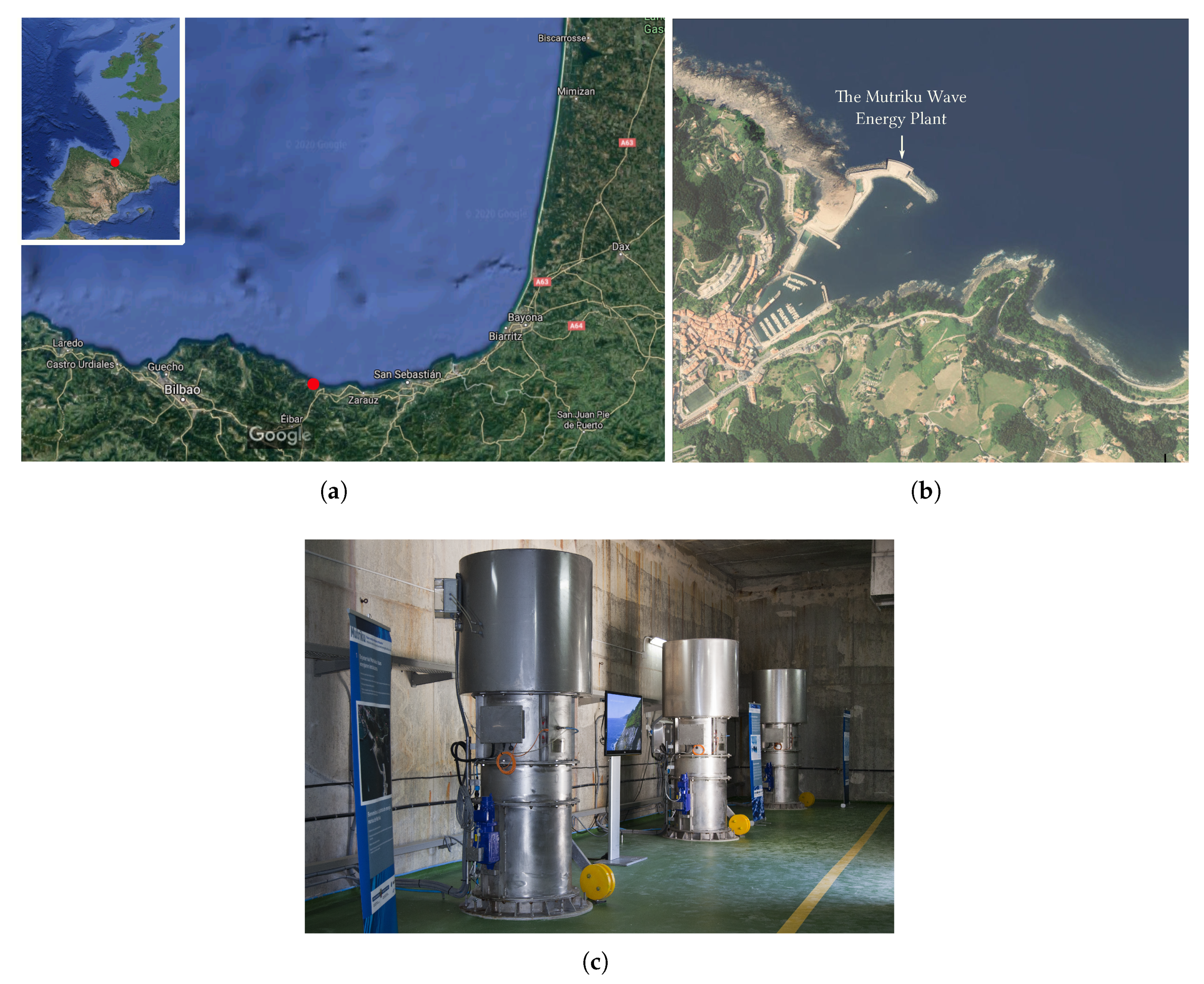
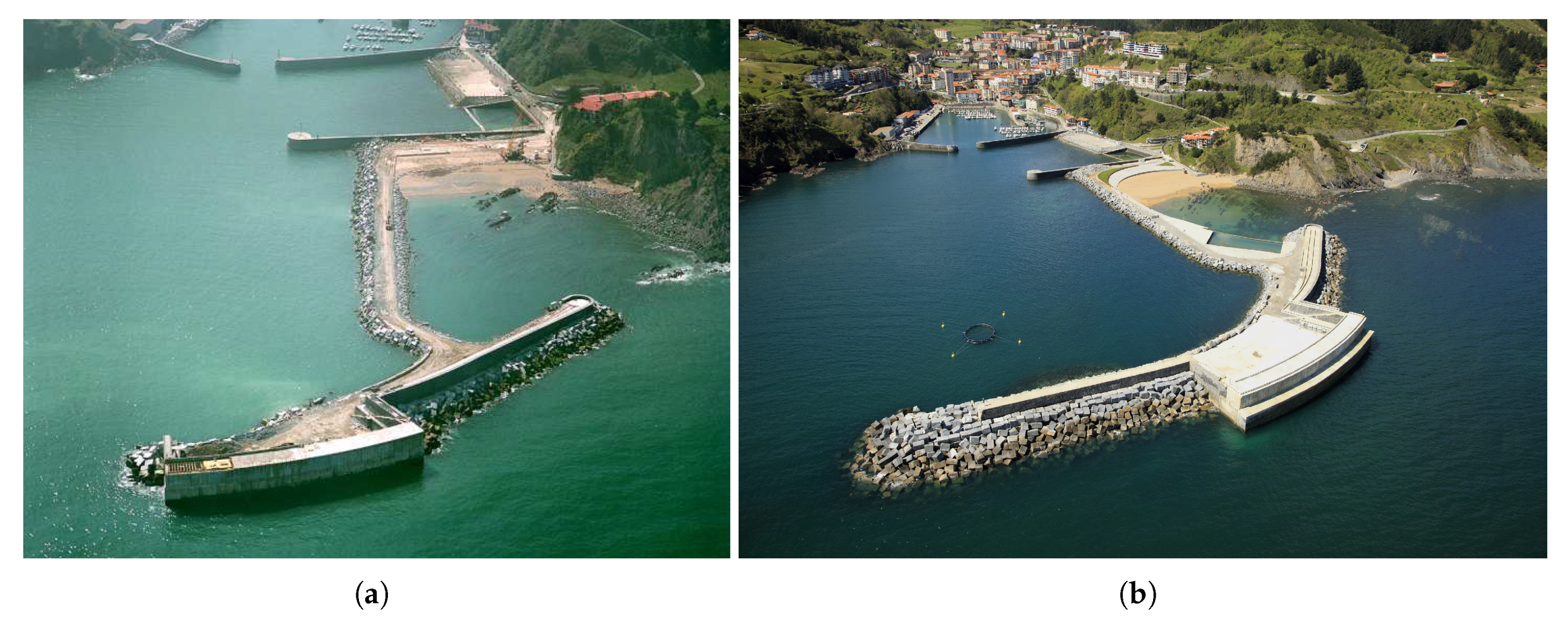
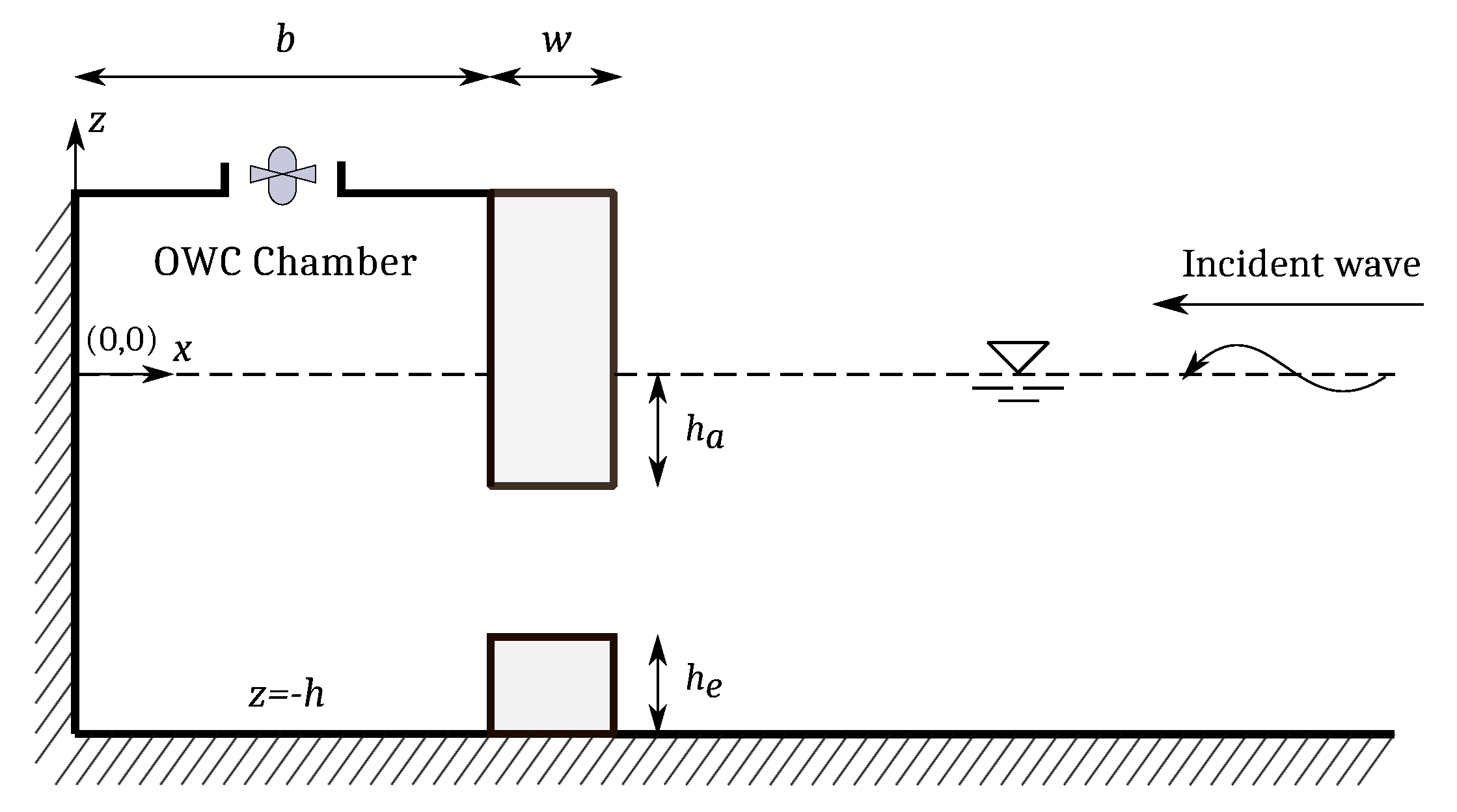

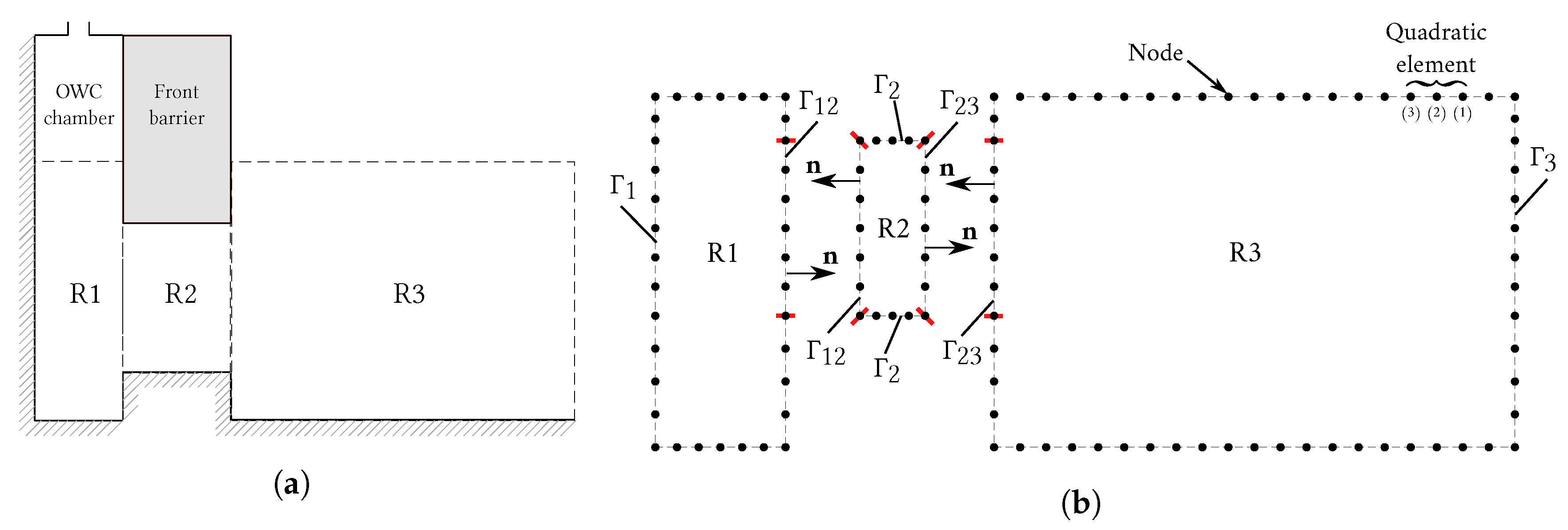
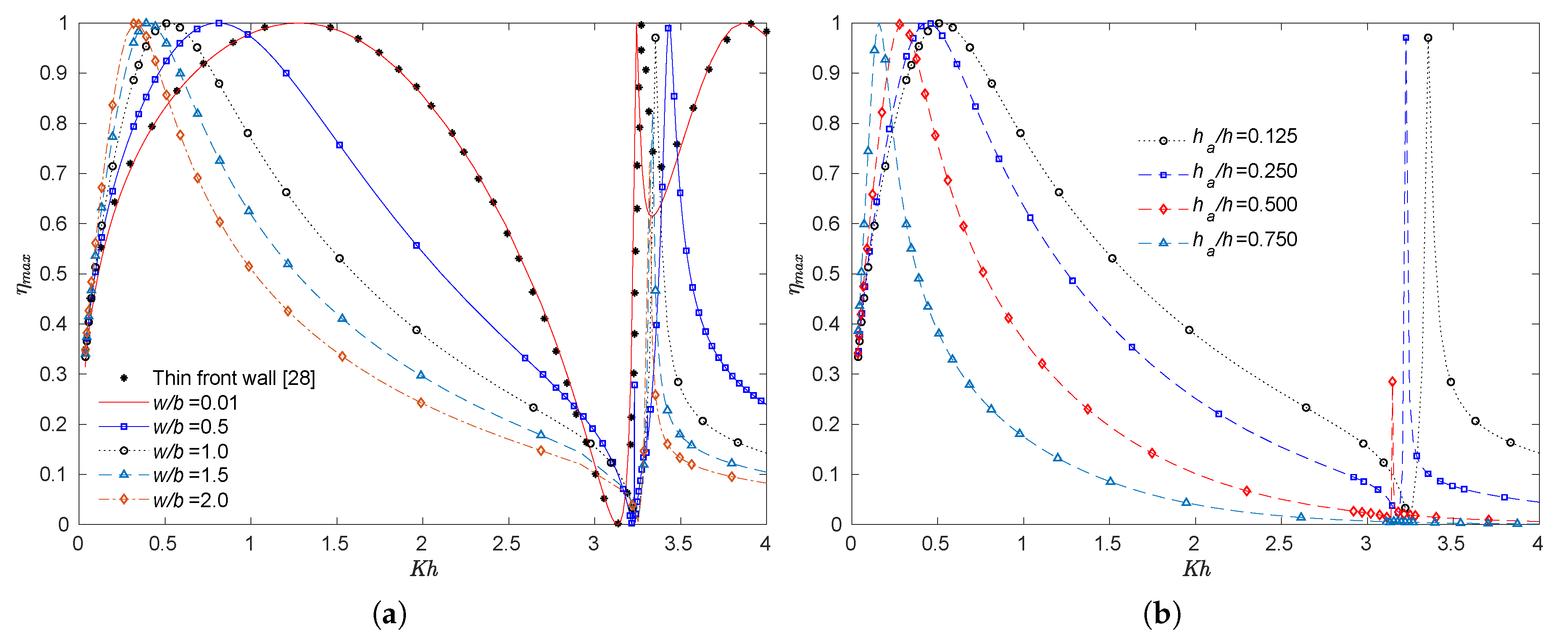
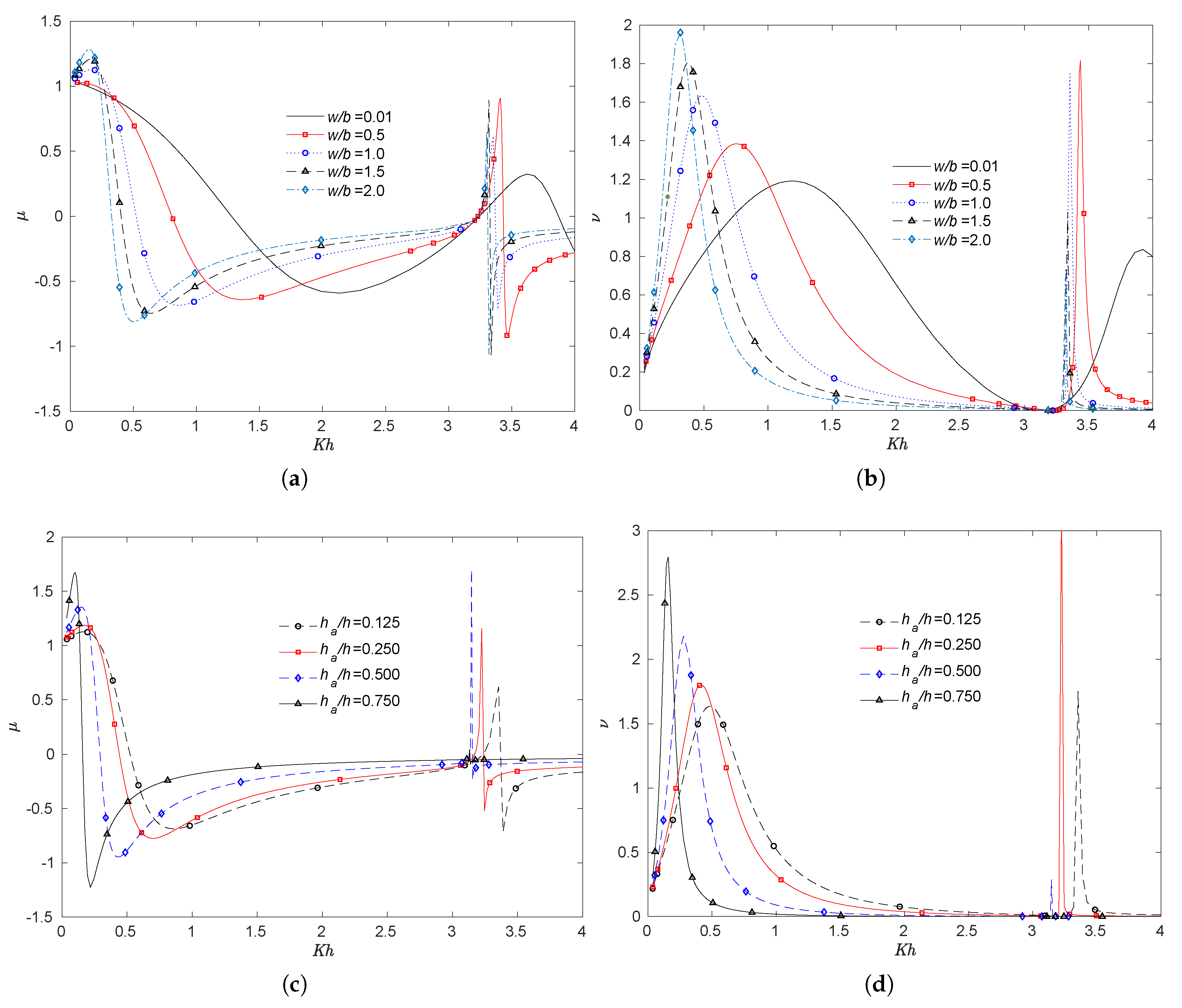

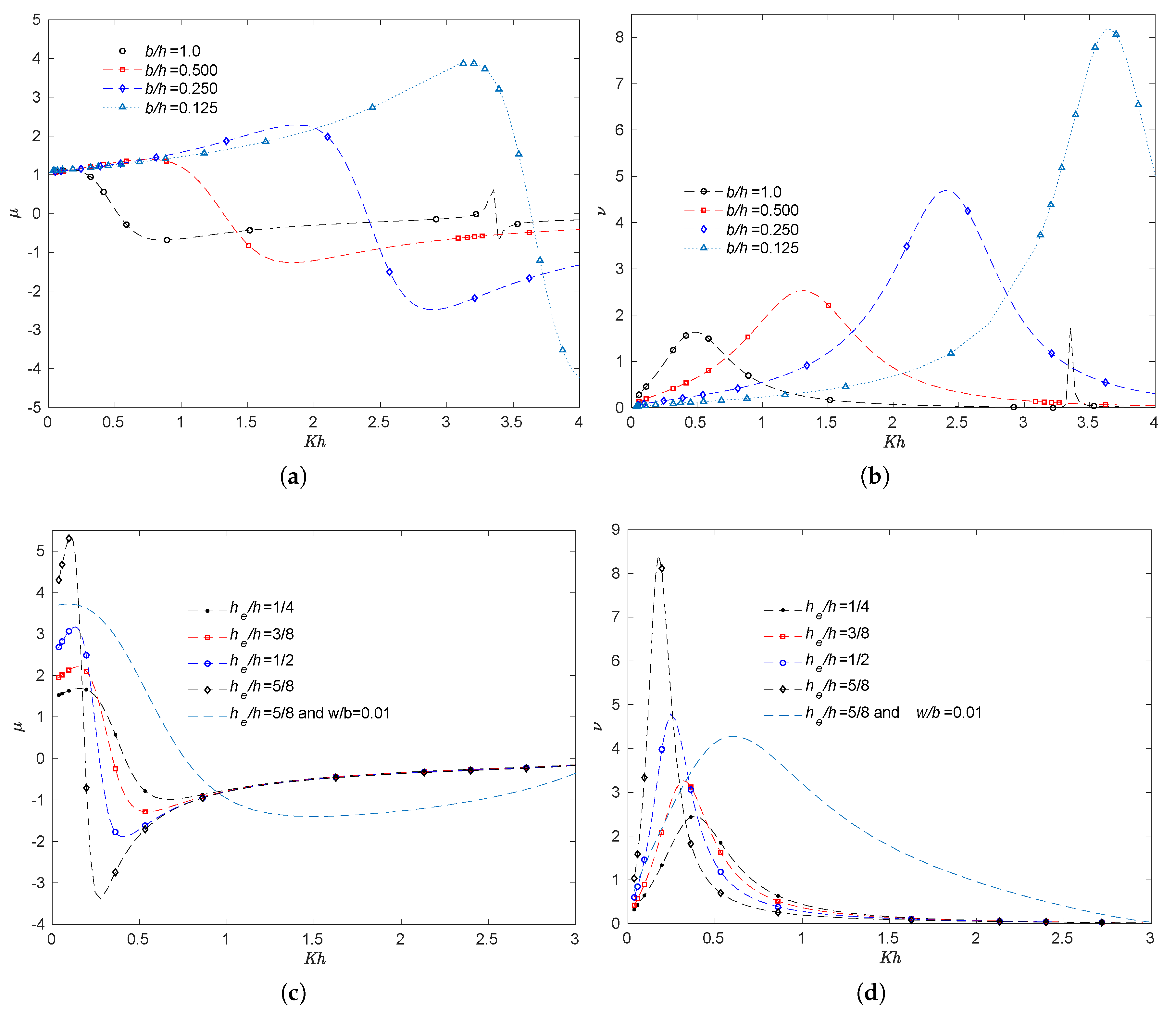

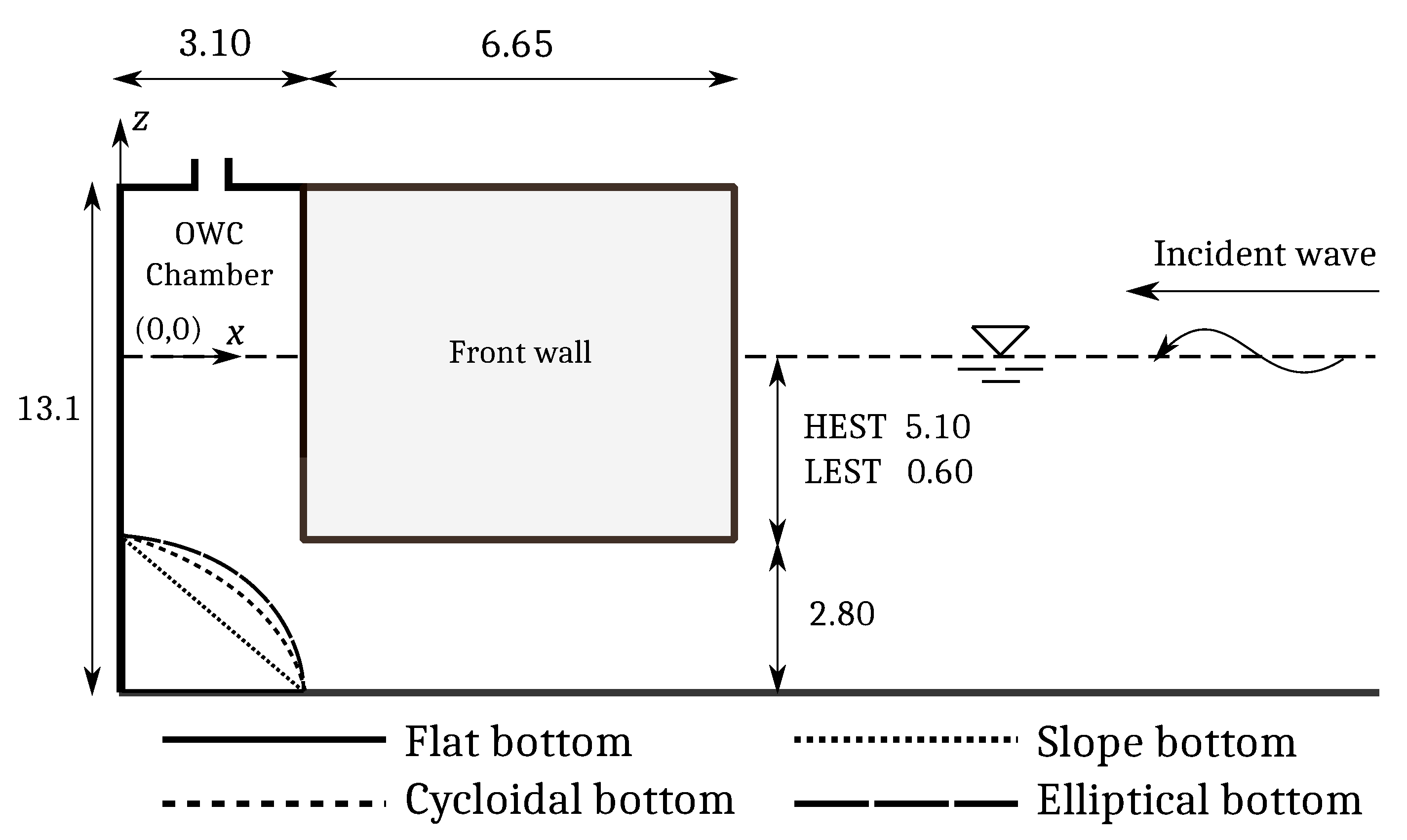
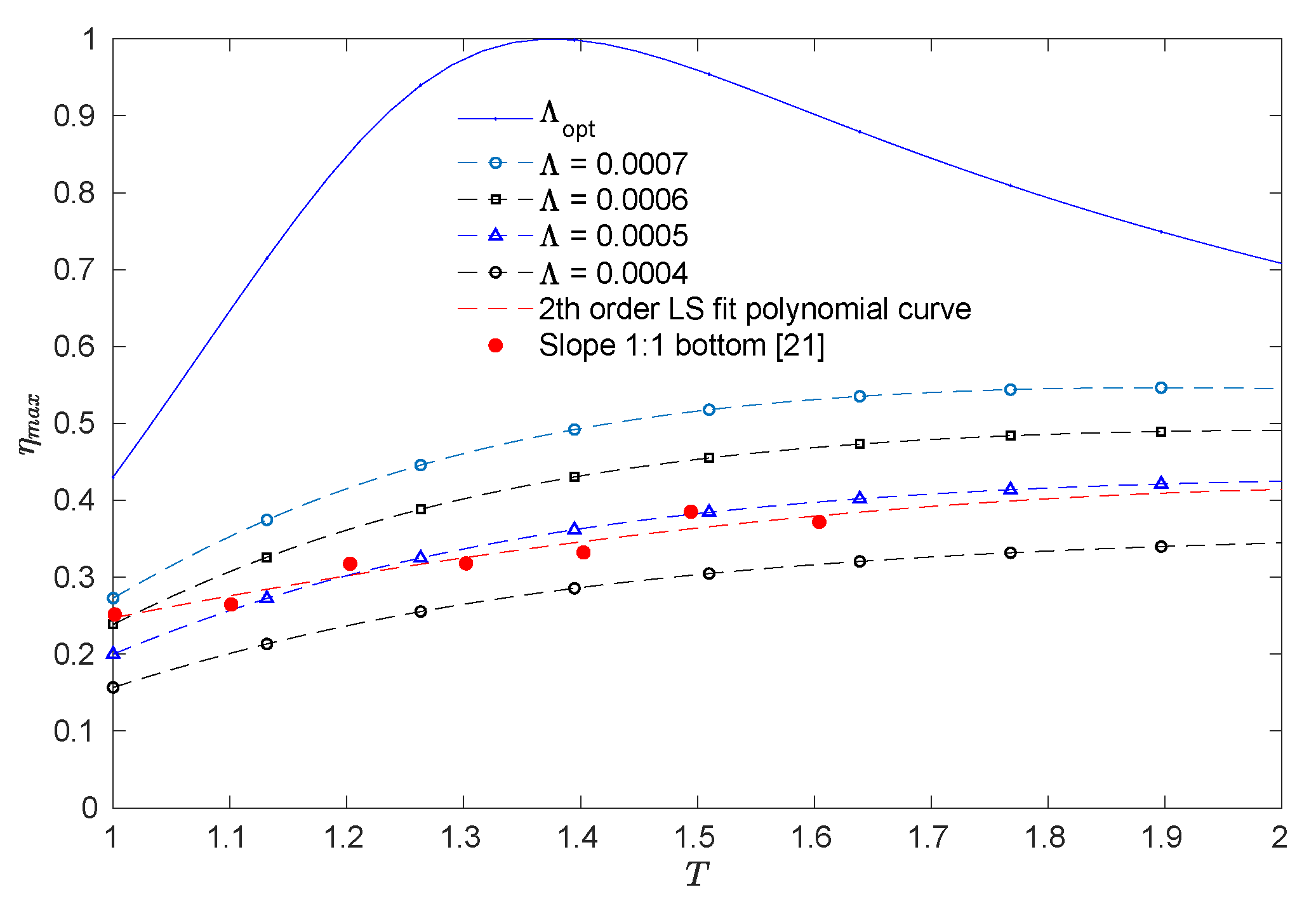

| N | 3.8329 | 2.2657 | 1.2054 | 0.5074 | ||||||||
|---|---|---|---|---|---|---|---|---|---|---|---|---|
| 560 | 0.2808 | −0.2926 | 0.0484 | 0.4335 | −0.3595 | 0.1035 | 0.8621 | −0.6287 | 0.7299 | 0.9425 | 0.6507 | 1.2787 |
| 480 | 0.2814 | −0.2940 | 0.0488 | 0.4337 | −0.3598 | 0.1037 | 0.8622 | −0.6295 | 0.7312 | 0.9425 | 0.6519 | 1.2806 |
| 400 | 0.2822 | −0.2957 | 0.0492 | 0.4340 | −0.3602 | 0.1039 | 0.8624 | −0.6305 | 0.7329 | 0.9424 | 0.6534 | 1.2830 |
| 328 | 0.2833 | −0.2982 | 0.0499 | 0.4343 | −0.3608 | 0.1042 | 0.8626 | −0.6318 | 0.7352 | 0.9423 | 0.6556 | 1.2861 |
| 256 | 0.2848 | −0.3018 | 0.0508 | 0.4349 | −0.3616 | 0.1046 | 0.8629 | −0.6338 | 0.7386 | 0.9422 | 0.6587 | 1.2906 |
| 200 | 0.2856 | −0.3071 | 0.0519 | 0.4370 | −0.3644 | 0.1061 | 0.8636 | −0.6373 | 0.7451 | 0.9418 | 0.6649 | 1.2978 |
© 2020 by the authors. Licensee MDPI, Basel, Switzerland. This article is an open access article distributed under the terms and conditions of the Creative Commons Attribution (CC BY) license (http://creativecommons.org/licenses/by/4.0/).
Share and Cite
Medina Rodríguez, A.A.; Blanco Ilzarbe, J.M.; Silva Casarín, R.; Izquierdo Ereño, U. The Influence of the Chamber Configuration on the Hydrodynamic Efficiency of Oscillating Water Column Devices. J. Mar. Sci. Eng. 2020, 8, 751. https://doi.org/10.3390/jmse8100751
Medina Rodríguez AA, Blanco Ilzarbe JM, Silva Casarín R, Izquierdo Ereño U. The Influence of the Chamber Configuration on the Hydrodynamic Efficiency of Oscillating Water Column Devices. Journal of Marine Science and Engineering. 2020; 8(10):751. https://doi.org/10.3390/jmse8100751
Chicago/Turabian StyleMedina Rodríguez, Ayrton Alfonso, Jesús María Blanco Ilzarbe, Rodolfo Silva Casarín, and Urko Izquierdo Ereño. 2020. "The Influence of the Chamber Configuration on the Hydrodynamic Efficiency of Oscillating Water Column Devices" Journal of Marine Science and Engineering 8, no. 10: 751. https://doi.org/10.3390/jmse8100751
APA StyleMedina Rodríguez, A. A., Blanco Ilzarbe, J. M., Silva Casarín, R., & Izquierdo Ereño, U. (2020). The Influence of the Chamber Configuration on the Hydrodynamic Efficiency of Oscillating Water Column Devices. Journal of Marine Science and Engineering, 8(10), 751. https://doi.org/10.3390/jmse8100751







